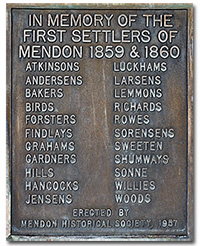Mendon Area History

I can think of no better way to help tell the history of Mendon, than through the personal histories, experiences and stories of the men and women who settled it. These are the records of pioneer times, of personal sacrifice and privation, when you would go hungry if your crop was not sufficient. The accounts of eating Sego roots and boiling the leather from shoes or belts, that one might have something to chew, are true. At the same time these are the people who helped to built the railroad, run the wires for the first telegraph line, established a city and built for themselves a church and school, log homes with dirt roofs and floors for their families. They did a lot, with very little.
The first real improvements in buildings would not begin until 1866 when the old rock church was finished and the first rock homes were under construction. All families at first lived in dugouts or crude log homes with dirt for a roof and floor, shingle mills would have to wait, lumber for floor planks were pit-sawed into crude slabs by hand, the log church being the only building in Mendon with a "proper" wood floor in it for many years. Logs were taken across the valley to "Millville," where they were slabbed into lumber. And these were the more fortunate of the early families, some of whom were forced to lived in dugouts, where in addition to the standard dirt roof and floor, most of the walls were to be dirt as well. The very poor settlers lived in just their wagon boxes, a very small, humble and cold existence, though I suppose they enjoyed a wood floor not much bigger than your kitchen table, but not the thin canvas over the hoops to keep out the cold wind and weather.
These are the stories of the families that broke through the native grass and sage, which had covered the floor of the Cache Valley for generations uncounted. They diverted the small streams to water their humble first crops, and later on constructed an earthen dam south of Mendon on Gardner's Creek to provide additional water for irrigation to several hundred acres of land. Water was the key element to life; it regulated the number of people who could reside in Mendon for many years. It mattered not that there was land to farm, for without water to bring forth a crop; it was only of value as pastureland, and even then only in the early part of the season.
They lived in a place in time, where one had to watch very carefully ones surroundings. Indians were a major problem for them in the first twenty odd years of the Mendon settlement. Bears, Grizzly bears, wolves, big cats, coyotes, snakes and all nature of wild things shared the same space as the early settlers of our beloved Mendon. Bradford K. Bird was shot in the leg; one of the Baker boys (Albert M. Baker) was shot in the hand, while checking the animals out back of his cabin one night, with an arrow. Had not the bone of his finger deflected the shot, he might have taken the arrow in his chest. Little Rosa Thurston was stolen by the Indians from Gardner's Creek, some three miles south of Mendon. Thomas B. Graham was almost torn in half by a huge grizzly bear with two cubs on the west bank of the Little Bear River, southeast of Mendon. One lady chased a bear from her log cabin with a skillet, another, Henrietta B. Shumway killed a bear that got into hers, then as now you don't want to be messing in mom's kitchen. Stories are told of visitations to Mendon by one or another of the Three Nephites
and of flour bins that never failed to contain enough to make a meal for a family, or those in need.
Mendon has a wonderful collection of histories, stories, recollections and folklore from which to draw upon for a glimpse into our collective past. Please enjoy these accounts offered here, for I am every so thankful that our pioneers, in addition to everything else they did left us a written record as well.